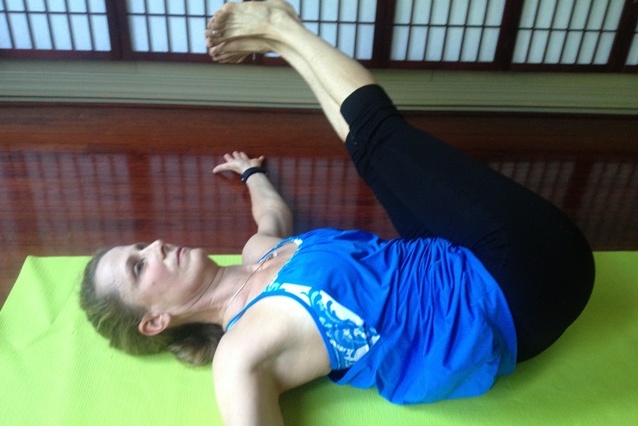Everything we think do or say creates karma; impressions that color the world and make us see it as we think it is, or how we want it to be, rather than as it truly exists. The point of practice is to become like a gardener and weed out these seeds, to be able to see the world as neutral. As Shakespeare said, “There is nothing that is good or bad, but thinking makes it so.” Whether we see something as good or bad is dependent on our karma, or which seeds are ripening at any particular time. One of the easiest books to read about seeds is How Yoga Works, by Geshe Michael Roche.
Y.S. 1.40 Paramanu paramamahattvantah asya vasikarah
Paramanu an infinitesimal, a particle, an atom
paramamahattvantah most distant, most excellent,highest, best, greatest
asya of this
vasikarah bringing into subjugation, havinf mastery over passions, or in one’s power
This sutra describes how the ordinary mind is transformed into a super-mind, where nothing is beyond comprehension. The mind can follow and understand then simple and the complex, the infinite and the infinitesimal, the perceptible and the imperceptible.
Y.S. 1.41 Ksinavrtteh abhijatatasya iva maneh grahitr grahanagrahyesutatstha tadanjanata samapattih
Ksina dissolving of the gunas: tamas, rajas and sattva
vrtteh modifications, fluctuations
abhijatatasya inborn, noble, courteous, polite
iva like
maneh a gem, flawless crystal
grahitr knower, taker, perceiver
grahana act of seizing, catching, accepting
grahyesu to be known
tatstha becoming stable
tadanjanata acquiring or taking the shape of the seen or the known
samapattih transformation, assuming the original form, consummation
When the mind is free from distraction, it is possible for all the mental processes to be involved in the object of inquiry. As one remains in this state, gradually one becomes immersed in the object. The mind then, like a flawless diamond, reflects only the features of the object and nothing else. The yogi realizes that the knower, the instrument of knowing and the known are one, himself, the seer.
Y.S. 1.42 Tatra sabdartha jnana vikalpaih samkirna savitarka samapattih
Tatra there
sabda word
artha purpose, aim, meaning
jnana knowing, knowledge, intelligence
vikalpaih an option, imagination, the act of allowing a rule to be observed or not as one pleases
samkirna poured together, mixed together
savitarka becoming totally engrossed, thoughtful
samapattih transformation
At this stage, called savitarka samapatti, the word, meaning and content are blended and become special knowledge
Y.S. 1.43 Smrti parisuddhau svarupasunya arthamatra nirbhasa nirvitarka
Smrti memory
parisuddhau completely cleansed, purest of minds
svarupasunya devoid of one’s nature
iva as it were
arthamatranirbhasa shining alone in purest form
nirvitarka unreflecting, unconsidered, without analysis or logic
In nirvitarka samapatti, the difference between memory and intellectual illumination is disclosed, memory is cleansed and consciousness shines without reflection. The mind becomes crystal clear and at one with the object. At this moment there is no feeling of oneself. This is pure perception.
Y.S. 1.44 Etayaiva savicara nirvicara ca suksma visaya vyakhyata
Etaya by this
eva also
savicara reflection, deliberation, consideration, investigation
nirvicara without reflection, not needing any consideration
ca and
suksmavisaya subtle object, subtle thing
vyakhyata related, explained, expounded, commented upon.
The contemplation of subtle aspects is similarly explained as deliberate, savicara samapatti or non-deliberate nirvicara samapatti
Y.S. 1.45 Suksma visayatvam ca alinga paryavasanam
Suksma subtle
visayatvam object
ca and
alinga having no characteristic mark, unmanifested form
paryavasanam ending
The subtlest level of nature is consciousness. When consciousness dissolves in nature, it loses all marks and becomes pure. By exploring the subtle particles of nature, consciousness reaches its goal. This is the state of the cessation of the fluctuations of the mind which is mentioned in the second Sutra. This state is considered to be the crossroads of Self-Realization.
Y.S. 1.46 Ta eva sabijas samadhih
Ta they
eva only
sabijas with seed
samadhih profound meditation or absorption
The states of Samadhi described in the previous sutras are dependent upon a support or seed and are termed sabija. These states are dependent on an object which includes the intelligence (buddhi) and the “I” principle (asmita). Their seed is the core of the being.
The six samapattis mentioned so far belong to functions of the brain. The source of analysis (savitarka) or absence of analysis (nirvitarka)is the frontal brain. For investigation and examination (savicara) or absence of them (nirvicara) the source is the back of the brain. The source of joy (ananda) is the base of the brain and of individuality (asmita) the top of the brain.
Through the disciplines of yoga, the practitioner (sadaka) transforms his attention from the gross to the subtle. When he reaches the apex of nature, the brain being a part of nature, he attains perfection in controlling the modes of consciousness. He is able to sop all functions of the brain, deliberate and non-deliberate at will. That is why it is termed Samadhi with seed.
Is it possible for an individual to reach this state of yoga? Yes, but it is important that they prepare themselves carefully, that they commit to steady practice and sustained interest to make progress. Without preparation there can be no foundation. And without gradual progression, the human system may react and rebel.
Y.S. 1.47 nirvicara vaisaradye dhyatma prasadah
nirvicara non-reflection, or reflection without seeds
vaisaradye I skillfulness, profound knowledge
dhyatma supreme soul (manifested as an individual soul) the relation between the supreme and individual soul
prasadah clearness, brightness
From proficiency in nirvicara samapatti comes purity. Sattva or luminosity flows undisturbed, kindling the spiritual light of the self. Or, then the individual begins to truly know himself.
Y.S. 1.48 rtambhara tatra prajna
rtambhara upholding truth, full of truth
tatra therein
prajna faculty of insight, wisdom
When consciousness dwells in wisdom, a truth-bearing state of direct spiritual perception dawns. What the practitioner sees and shares with others is free from error.
Y.S. 1.49 Sruta anumana prajna abhyam anya visaya visesa arthatvat
Sruta heard, listened or ascertained
anumana inference, conjecture
prajnabhyam from the wisdom of insight
anyavisaya other object
visesa peculiar, distinguishing between, special property
arthatvat object, purpose, aim, end
Knowledge is no longer based on memory or inference. It is spontaneous, direct and at a level and intensity that is beyond the ordinary.
Y.S. 1.50 Tajjas samskarro anyasamskara pratibandhi
Tajjas Born or sprung from
samskarro conception, instinct, formation in the mind, impressions acquired by effort are subliminal (samskara), and recollecting them is an impression or memory.
anyasamskara other impressions, other conceptions or formations
pratibandhi contradicting, objecting, impeding
A new life begins with this truth-bearing light. Previous impressions are left behind and new ones are prevented.
Y.S. 1.51 Tasyapi nirodhe sarva nirodhat nirbijah Samadhi
Tasyapi that too
nirodhe by shutting, closing, restraining, destroying, by cessation
sarva all
nirodhat checking, suppressing, destrouing
nirbijah seedless
Samadhi profound meditation
When that new light of wisdom is also relinquished, seedless Samadhi dawns.
The practitioner must learn to restrain even this new impression of truth-bearing light. When both old and new impressions are dissolved, a state of seedless enlightenment arises, in which all allusions and delusions terminate. This is nirbijah Samadhi, the state of absolute identity with the seer. This is the ultimate state of Samadhi.
Such comprehension is not sought. It comes inevitably and nothing can stop it. This state cannot be described in words. Only those who have reached this state can comprehend it.











